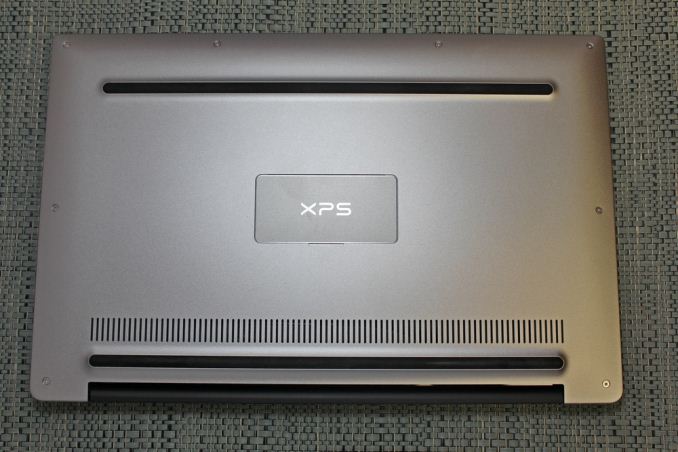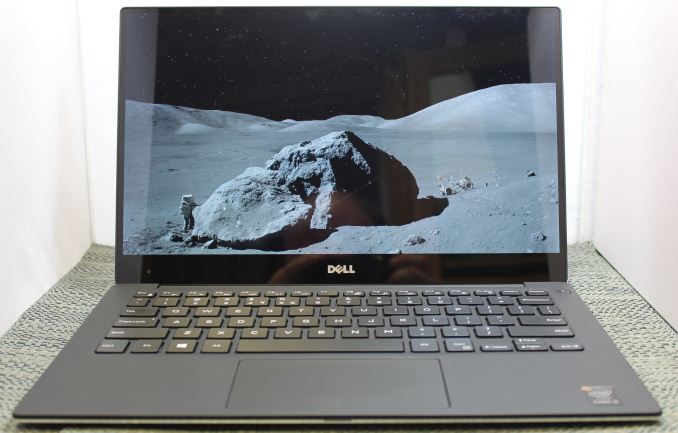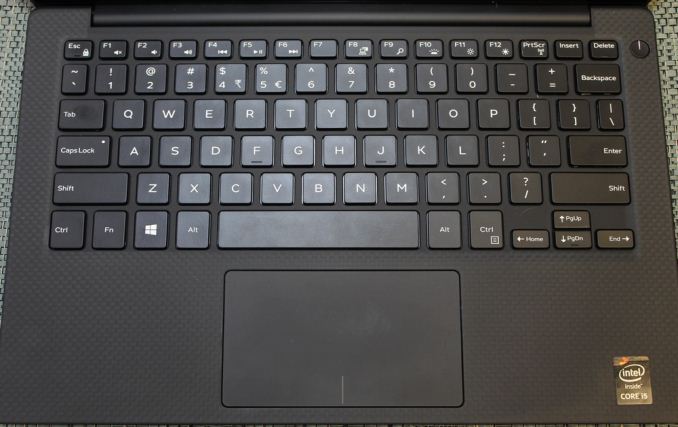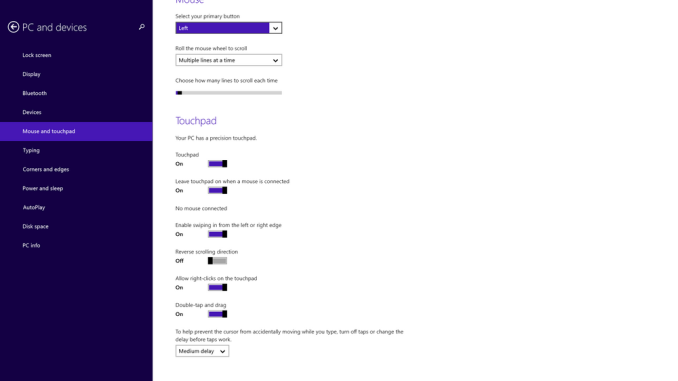Dell XPS 13 Review
by Brett Howse on February 19, 2015 9:00 AM EST- Posted in
- Laptops
- Dell
- Ultrabook
- Broadwell-U
- XPS 13
Design and Chassis
The design of the XPS 13 is the first thing you see, and you would be hard pressed to find anyone who does not think Dell has done a great job with the overall intention. From the external aluminum shell, to the carbon fibre palm rest, to the super thin bezels, the XPS 13 is undeniably a great looking laptop.
Dell has really squeezed the dimensions down for this device. To say that it is a 13 inch laptop in an 11 inch chassis, we should see just how close they got. The Dell XPS 13's dimensions are listed as 11.98 inches (304mm) wide, and 7.88 inches (200mm) deep. Compare this to the MacBook Air 13, which is 12.8 inches (325mm) x 8.94 inches (227mm), and right away it is clear that the Dell is quite a bit smaller. The MacBook Air 11 is much closer in size, at 11.8 inches (300mm) x 7.56 inches (192mm). So truly, the lack of display bezels has changed what we would think of as a 13 inch laptop. If more devices go this route, which they likely will, there will be much more display per unit of laptop going forward.
The outer shell of the XPS 13 is completely aluminum, on the top and bottom. This gives the design a premium feel with the very first touch, and compared to the plastic of most notebooks, it is a big step up in terms of materials and finish. While not milled out of a single piece of aluminum, the exterior looks and feels very nicely made. With the notebook closed, there is a black strip around the center, which gives a sharp contrast. Dell paid attention to the bottom of the device as well, with a magnetic plate, hinged on one side, covering the service tag and serial number to keep the bottom looking clean and unblemished.
The left side features the mini DisplayPort output, as well as a USB 3.0 port with PowerShare (you can charge devices while the laptop is powered off) and the headset jack. The speakers are on the sides on the XPS 13, so the left has an unobtrusive speaker grille as well as the battery meter. The right side features another USB 3.0 port, also with PowerShare, as well as the Noble lock and the SD card slot. The second speaker grille adorns the front right of the notebook. The front of the laptop has a single light, which glows when the laptop is charging and flashes yellow when the battery is critical. This makes it easy to tell when the laptop is fully charged and is a nice addition.
The underside of the XPS 13 consists of two full width rubber feet. This makes it plenty sturdy to use on almost any surface and keeps the device stable even on uneven surfaces. The fan intake and exhaust is also under the laptop, which helps keep the noise of the fan at bay. Yes, there is a fan. Broadwell-U promises to be more power efficient, but it is still rated at 15 watts so that heat must be removed.
Once you open the XPS 13, you will be face to face with the wonderful display, which takes up almost the entire width of the device. With bezels only 5.2 mm thin, Dell is marketing this as an Infinity Display, and while it is not quite the same as an Infinity Pool it is still a great effect. Laptop bezels have been quite large for a long time and this new device will hopefully usher in a push to smaller bezels on all laptops.
The XPS 13 does have a larger bezel at the bottom, which serves a couple of purposes. The extra height allows Dell to keep the depth of the laptop larger, which makes more room for the trackpad, and the front facing camera also finds its home in the bottom bezel. This does make it less effective though, and perhaps Dell can find a way to squeeze it back on top without adding too much thickness to the top bezel.
The keyboard is an island style, completely surrounded in carbon fiber. This is then covered with a soft touch paint, which makes it a lot more comfortable to type on than something with an aluminum top and sharp sides. The weave of the carbon fiber still shows through and gives it a great look. The keyboard itself is also quite good for an Ultrabook and the small travel that they entail. The key layout is also fairly standard, and while I prefer dedicated Page Up/Down, Home , and End keys, that would be tough to do on a laptop this small without sacrificing something else. The up/down/left/right keys are well placed and easy to use.
Below the keyboard is the clickpad. Dell has opted to forego the third party drivers and sticks with the Microsoft Precision trackpad model. This moves the settings into Windows and makes them more consistent. There seems to have been no issue with doing this, as the clickpad was responsive and accurate. I do prefer dedicated buttons, but on a device this small that would take away too much trackpad space, so a clickpad is the better choice here.
Overall, Dell has created a great design in the XPS 13. It keeps with some of the Dell traditional designs, but the sharper edges and smaller radius corners contribute to an overall better look. That coupled with the premium feel of the materials, the good keyboard and trackpad, and the very small display bezels, make the XPS 13 one of the more attractive laptops around.

















201 Comments
View All Comments
Brett Howse - Monday, March 23, 2015 - link
Someone else had asked me that, so I set the 3200x1800 display to 1600x900, just to see if part of the battery life loss was due to rendering. My battery life test for this setting was almost identical to the 3200x1800 resolution.So it does not improve battery life because the main power draw of the higher resolution display is the increased requirements of the backlight to drive the same brightness level through a much more dense TFT. At least that was my findings on the XPS 13.
growl - Monday, March 23, 2015 - link
Thanks very much, appreciate it! Torn on which one to buy, given that I am a frequent traveler, but also generally enjoy touch and have a pretty much unlimited budget.mazzy - Thursday, March 26, 2015 - link
Hi Brett, Any Update on Auto Dynamic LCD brightness ?Brett Howse - Saturday, March 28, 2015 - link
Nothing yet sorry.mazzy - Tuesday, April 7, 2015 - link
I think that it'll never be fixed. It's April.. over 3 months from the launch...It's a pity, a great quality screen but with a glaring defect... no calibration possible... :(
FranC - Wednesday, April 8, 2015 - link
I bought the 2015 Dell XPS 13 on the assumption that Dell would release a fix that would allow end users to calibrate the display. As mazzy said, it seems like Dell has no intention of fixing this, perhaps because it would reveal that battery life is highly dependent on Adaptive Brightness being enabled. Guess I'll wait to the last day to return it, and file this one away as being Duped-by-Dell.paul1508 - Monday, April 20, 2015 - link
Does the standard Dell Wireless 1560 support Intel Wireless Display (WiDi) or do I have to opt in the Intel AC 7260? Does that matter at all because the Dell Wireless 1560 might support Miracast?technoway - Monday, April 27, 2015 - link
The battery life for the system:i7-5500U / 8GB-RAM / 512GB-SSD / 3200x1800 infinity touch
is listed to be only about 7.5 hours.
The Apple 13-inch Macbook gets 10 hours or more.
But, Dell doesn't offer the 512 GB SSD, which I need for space, without also having the power-sucking HD+ screen. That stops me from buying the latest XPS-13.
Dell could make simple changes and make a machine I'd buy, but for some reason they don't do this.
The core i7 processor is a must, because it consumes less power than the core i5, and a 512 GB SSD is also a must to compete with Apple machines, but the HD+ screen wastes too much power. An HD screen is just fine on a 13-inch machine.
Until I can get a i7-5500U / 8GB-RAM / 512GB-SSD, with just the HD display (I don't care whether it's touch or not), I won't buy this. With the HD display, that system would have great battery life - I'd estimate at least 10 hours, and probably more like 11 or 12, maybe more. Dell ruins the machine by not offering the best options for battery life.
I do have an older first-generation XPS 13, and I like it, but with a meager 128 GB, 70 GB taken by the OS and restore partition, it's got too little storage.
If Dell makes the machine I want, I'll buy one tomorrow. If they don't make that by Christmas, I'll probably purchase the Apple 13 inch model. It has the good battery life for an Ultrabook.
Oh, and Dell's suggested solution for the poorer battery life is to carry around a plug-in battery pack for extra power. That competely defeats the purpose of having an Ultrabook!
vaga13ond - Saturday, June 11, 2016 - link
You're comparing apples to oranges there. Trying to compare the XPS vs a Macbook isn't really targeting the same user. Macbook's come with Core m3 or m5 (below i-series) processors not the i7 processor that you consider a "must." No touch screen, no QHD, worse on board graphics, DDR3, single port, yada yada yada... And no, the Macbook does NOT get 17.5+ hours on a battery charge doing anything besides idling. The XPS is a VERY different machine than the Apple Macbook...rgin - Monday, October 12, 2015 - link
Would the performance of this beauty be affected if we ran linux on it?